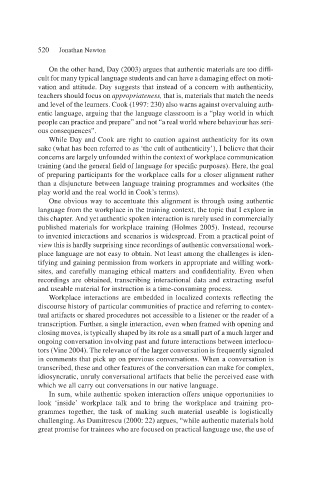Page 542 - Handbooks of Applied Linguistics Communication Competence Language and Communication Problems Practical Solutions
P. 542
520 Jonathan Newton
On the other hand, Day (2003) argues that authentic materials are too diffi-
cult for many typical language students and can have a damaging effect on moti-
vation and attitude. Day suggests that instead of a concern with authenticity,
teachers should focus on appropriateness, that is, materials that match the needs
and level of the learners. Cook (1997: 230) also warns against overvaluing auth-
entic language, arguing that the language classroom is a “play world in which
people can practice and prepare” and not “a real world where behaviour has seri-
ous consequences”.
While Day and Cook are right to caution against authenticity for its own
sake (what has been referred to as ‘the cult of authenticity’), I believe that their
concerns are largely unfounded within the context of workplace communication
training (and the general field of language for specific purposes). Here, the goal
of preparing participants for the workplace calls for a closer alignment rather
than a disjuncture between language training programmes and worksites (the
play world and the real world in Cook’s terms).
One obvious way to accentuate this alignment is through using authentic
language from the workplace in the training context, the topic that I explore in
this chapter. And yet authentic spoken interaction is rarely used in commercially
published materials for workplace training (Holmes 2005). Instead, recourse
to invented interactions and scenarios is widespread. From a practical point of
view this is hardly surprising since recordings of authentic conversational work-
place language are not easy to obtain. Not least among the challenges is iden-
tifying and gaining permission from workers in appropriate and willing work-
sites, and carefully managing ethical matters and confidentiality. Even when
recordings are obtained, transcribing interactional data and extracting useful
and useable material for instruction is a time-consuming process.
Workplace interactions are embedded in localized contexts reflecting the
discourse history of particular communities of practice and referring to contex-
tual artifacts or shared procedures not accessible to a listener or the reader of a
transcription. Further, a single interaction, even when framed with opening and
closing moves, is typically shaped by its role as a small part of a much larger and
ongoing conversation involving past and future interactions between interlocu-
tors (Vine 2004). The relevance of the larger conversation is frequently signaled
in comments that pick up on previous conversations. When a conversation is
transcribed, these and other features of the conversation can make for complex,
idiosyncratic, unruly conversational artifacts that belie the perceived ease with
which we all carry out conversations in our native language.
In sum, while authentic spoken interaction offers unique opportunities to
look ‘inside’ workplace talk and to bring the workplace and training pro-
grammes together, the task of making such material useable is logistically
challenging. As Dumitrescu (2000: 22) argues, “while authentic materials hold
great promise for trainees who are focused on practical language use, the use of

